TESLA ROADSTER 2008 Manual Online
Manufacturer: TESLA, Model Year: 2008, Model line: ROADSTER, Model: TESLA ROADSTER 2008Pages: 115, PDF Size: 46.35 MB
Page 81 of 115
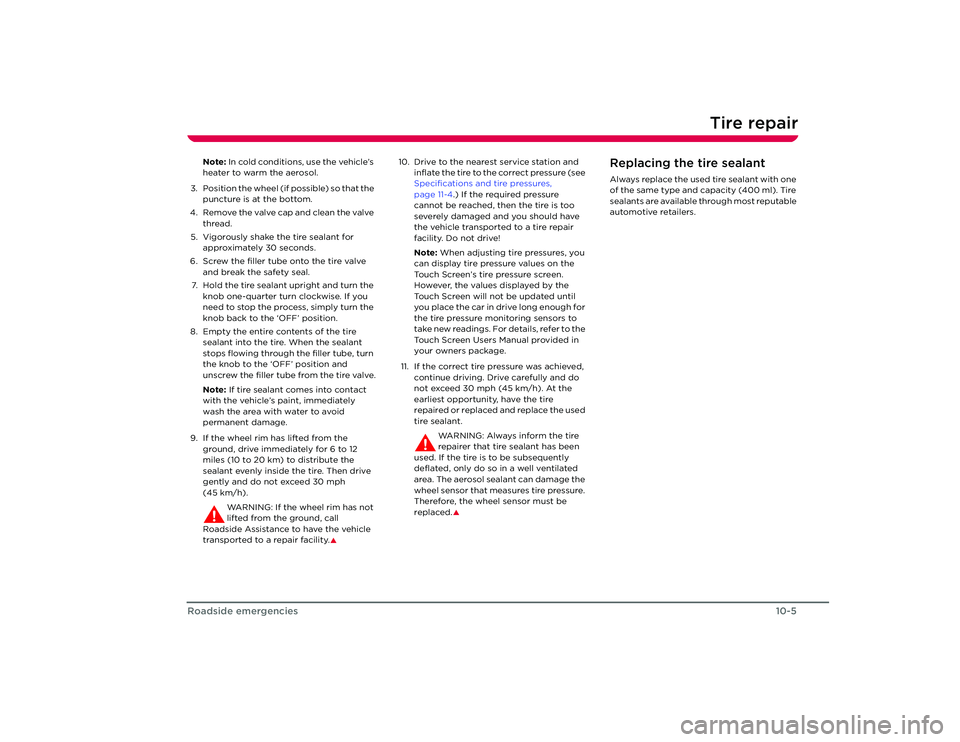
Tire repair
10-5
Roadside emergencies
Note: In cold conditions, use the vehicle’s
heater to warm the aerosol.
3. Position the wheel (if possible) so that the puncture is at the bottom.
4. Remove the valve cap and clean the valve thread.
5. Vigorously shake the tire sealant for approximately 30 seconds.
6. Screw the filler tube onto the tire valve and break the safety seal.
7. Hold the tire sealant upright and turn the knob one-quarter turn clockwise. If you
need to stop the process, simply turn the
knob back to the ‘OFF’ position.
8. Empty the entire contents of the tire sealant into the tire. When the sealant
stops flowing through the filler tube, turn
the knob to the ‘OFF’ position and
unscrew the filler tube from the tire valve.
Note: If tire sealant comes into contact
with the vehicle’s paint, immediately
wash the area with water to avoid
permanent damage.
9. If the wheel rim has lifted from the ground, drive immediately for 6 to 12
miles (10 to 20 km) to distribute the
sealant evenly inside the tire. Then drive
gently and do not exceed 30 mph
(45 km/h).
WARNING: If the wheel rim has not
lifted from the ground, call
Roadside Assistance to have the vehicle
transported to a repair facility.
�S
10. Drive to the nearest service station and inflate the tire to the correct pressure (see
Specifications and tire pressures,
page 11-4 .) If the required pressure
cannot be reached, then the tire is too
severely damaged and you should have
the vehicle transported to a tire repair
facility. Do not drive!
Note: When adjusting tire pressures, you
can display tire pressure values on the
Touch Screen’s tire pressure screen.
However, the values displayed by the
Touch Screen will not be updated until
you place the car in drive long enough for
the tire pressure monitoring sensors to
take new readings. For details, refer to the
Touch Screen Users Manual provided in
your owners package.
11. If the correct tire pressure was achieved, continue driving. Drive carefully and do
not exceed 30 mph (45 km/h). At the
earliest opportunity, have the tire
repaired or replaced and replace the used
tire sealant.
WARNING: Always inform the tire
repairer that tire sealant has been
used. If the tire is to be subsequently
deflated, only do so in a well ventilated
area. The aerosol sealant can damage the
wheel sensor that measures tire pressure.
Therefore, the wheel sensor must be
replaced.
�S
Replacing the tire sealantAlways replace the used tire sealant with one
of the same type and capacity (400 ml). Tire
sealants are available through most reputable
automotive retailers.
Roadster OHB.book Page 5 Th ursday, October 2, 2008 8:59 AM
Page 82 of 115
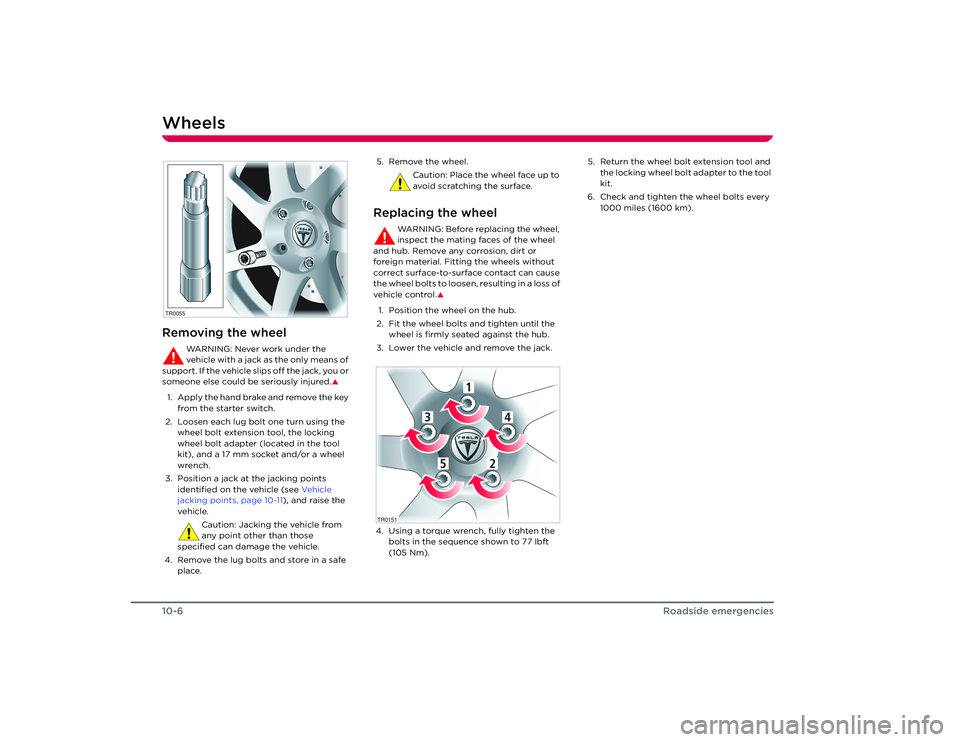
Wheels10-6
Roadside emergencies
WheelsRemoving the wheel
WARNING: Never work under the
vehicle with a jack as the only means of
support. If the vehicle slips off the jack, you or
someone else could be seriously injured.
�S
1. Apply the hand brake and remove the key from the starter switch.
2. Loosen each lug bolt one turn using the wheel bolt extension tool, the locking
wheel bolt adapter (located in the tool
kit), and a 17 mm socket and/or a wheel
wrench.
3. Position a jack at the jacking points identified on the vehicle (see Ve h i c l e
jacking points, page 10-11 ), and raise the
vehicle.
Caution: Jacking the vehicle from
any point other than those
specified can damage the vehicle.
4. Remove the lug bolts and store in a safe place. 5. Remove the wheel.
Caution: Place the wheel face up to
avoid scratching the surface.
Replacing the wheel
WARNING: Before replacing the wheel,
inspect the mating faces of the wheel
and hub. Remove any corrosion, dirt or
foreign material. Fitting the wheels without
correct surface-to-surface contact can cause
the wheel bolts to loosen, resulting in a loss of
vehicle control.
�S
1. Position the wheel on the hub.
2. Fit the wheel bolts and tighten until the wheel is firmly seated against the hub.
3. Lower the vehicle and remove the jack.
4. Using a torque wrench, fully tighten the bolts in the sequence shown to 77 lbft
(105 Nm). 5. Return the wheel bolt extension tool and
the locking wheel bolt adapter to the tool
kit.
6. Check and tighten the wheel bolts every 1000 miles (1600 km).
TR0055
1
4
3
5
2
1
4
3
5
2
TR0151
Roadster OHB.book Page 6 Th ursday, October 2, 2008 8:59 AM
Page 83 of 115
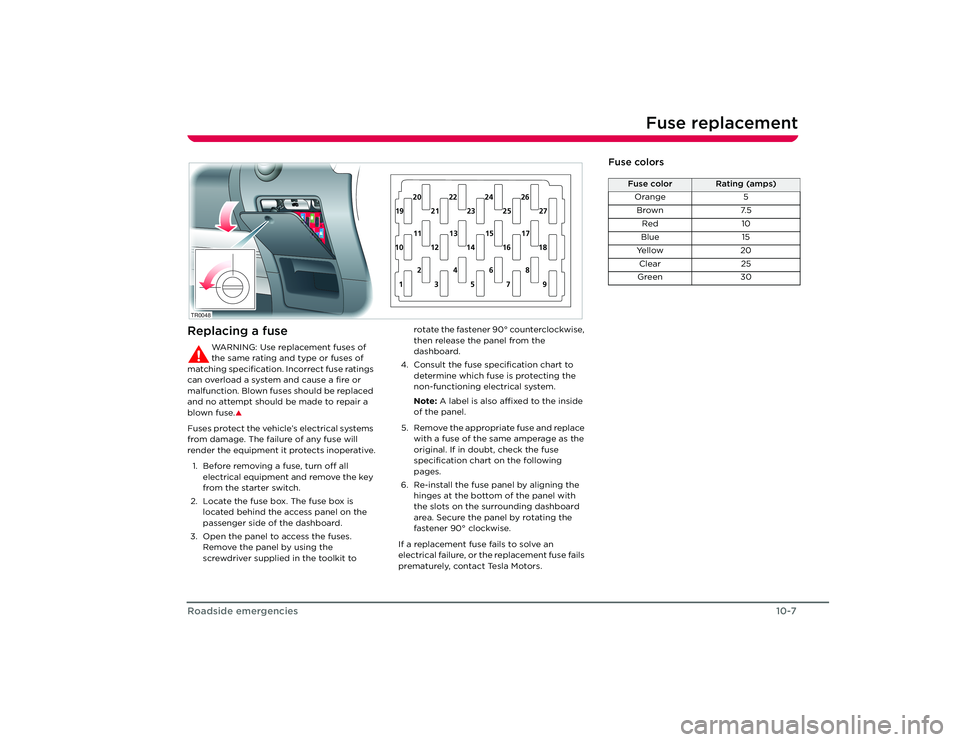
Fuse replacement
10-7
Roadside emergencies
Fuse replacementReplacing a fuse
WARNING: Use replacement fuses of
the same rating and type or fuses of
matching specification. Incorrect fuse ratings
can overload a system and cause a fire or
malfunction. Blown fuses should be replaced
and no attempt should be made to repair a
blown fuse.
�S
Fuses protect the vehicle’s electrical systems
from damage. The failure of any fuse will
render the equipment it protects inoperative.
1. Before removing a fuse, turn off all electrical equipment and remove the key
from the starter switch.
2. Locate the fuse box. The fuse box is located behind the access panel on the
passenger side of the dashboard.
3. Open the panel to access the fuses. Remove the panel by using the
screwdriver supplied in the toolkit to rotate the fastener 90° counterclockwise,
then release the panel from the
dashboard.
4. Consult the fuse specification chart to determine which fuse is protecting the
non-functioning electrical system.
Note: A label is also affixed to the inside
of the panel.
5. Remove the appropriate fuse and replace with a fuse of the same amperage as the
original. If in doubt, check the fuse
specification chart on the following
pages.
6. Re-install the fuse panel by aligning the hinges at the bottom of the panel with
the slots on the surrounding dashboard
area. Secure the panel by rotating the
fastener 90° clockwise.
If a replacement fuse fails to solve an
electrical failure, or the replacement fuse fails
prematurely, contact Tesla Motors.TR0048
13579 2468
11 13 15 17
20 22 24 26
10 12 14 16 18 19 21 23 25 27
Fuse colors
Fuse color
Rating (amps)
Orange 5
Brown 7.5
Red 10
Blue 15
Yellow 20
Clear 25
Green 30
Roadster OHB.book Page 7 Th ursday, October 2, 2008 8:59 AM
Page 84 of 115
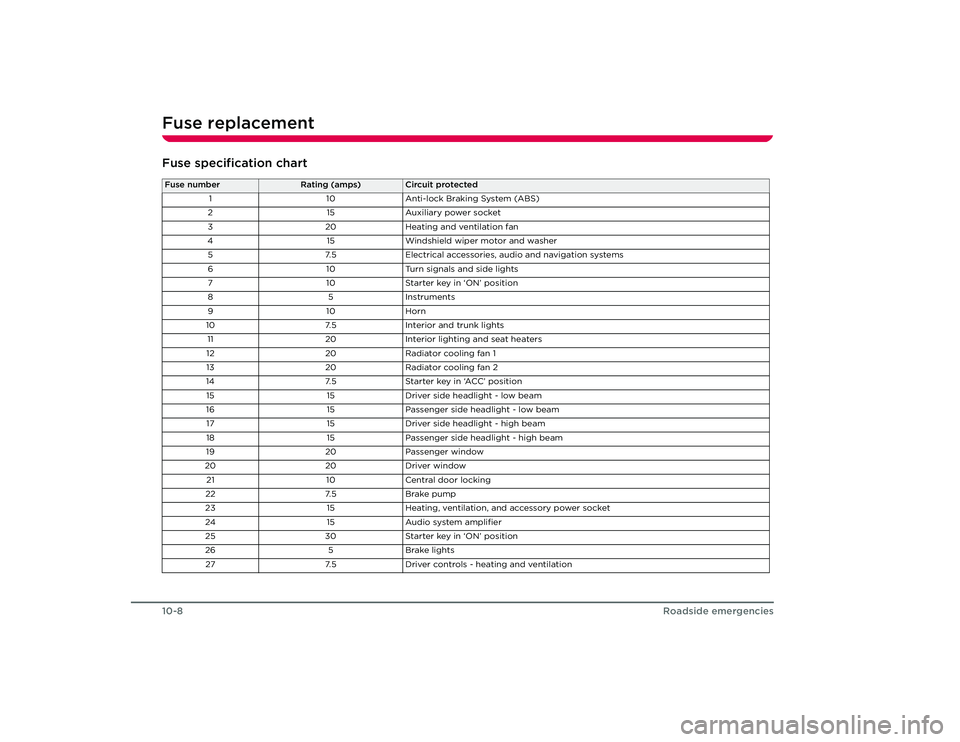
Fuse replacement10-8
Roadside emergencies
Fuse specification chartFuse number
Rating (amps)
Circuit protected
1 10Anti-lock Braking System (ABS)
2 15Auxiliary power socket
3 20Heating and ventilation fan
4 15Windshield wiper motor and washer
5 7.5Electrical accessories, audio and navigation systems
6 10Turn signals and side lights
7 10Starter key in ‘ON’ position
85 In stru m en ts
91 0Horn
10 7.5Interior and trunk lights
11 20Interior lighting and seat heaters
12 20Radiator cooling fan 1
13 20Radiator cooling fan 2
14 7.5Starter key in ‘ACC’ position
15 15Driver side headlight - low beam
16 15Passenger side headlight - low beam
17 15Driver side headlight - high beam
18 15Passenger side headlight - high beam
19 20Passenger window
20 20Driver window
21 10Central door locking
22 7.5Brake pump
23 15Heating, ventilation, and accessory power socket
24 15Audio system amplifier
25 30Starter key in ‘ON’ position
26 5Brake lights
27 7.5Driver controls - heating and ventilation
Roadster OHB.book Page 8 Th ursday, October 2, 2008 8:59 AM
Page 85 of 115
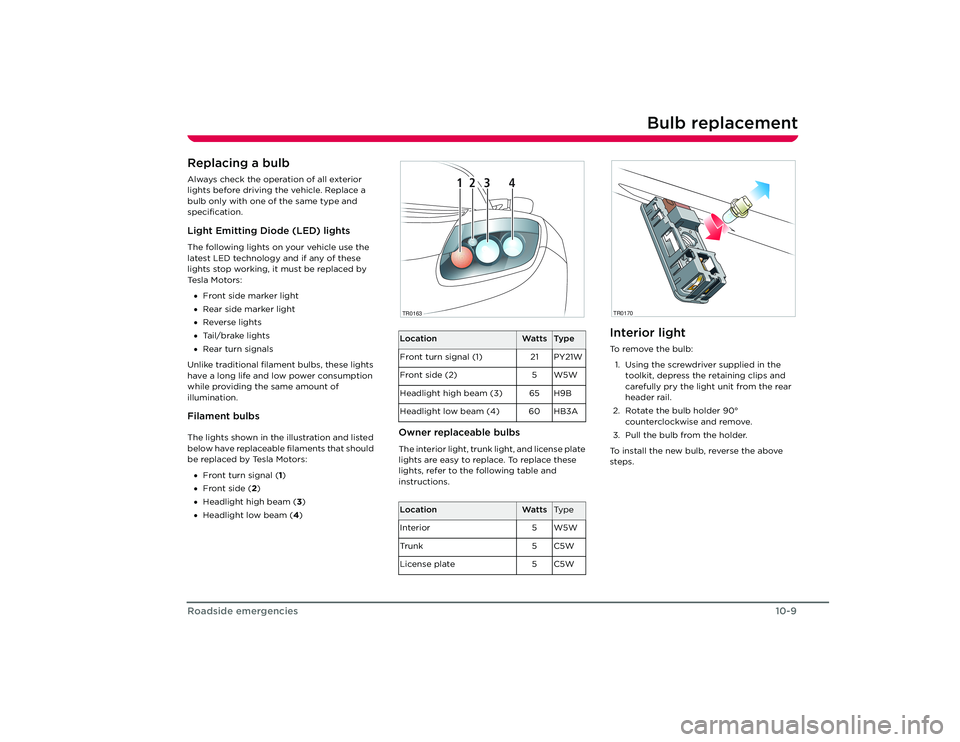
Bulb replacement
10-9
Roadside emergencies
Bulb replacementReplacing a bulbAlways check the operation of all exterior
lights before driving the vehicle. Replace a
bulb only with one of the same type and
specification.Light Emitting Diode (LED) lightsThe following lights on your vehicle use the
latest LED technology and if any of these
lights stop working, it must be replaced by
Te s l a M o t o r s :
• Front side marker light
• Rear side marker light
• Reverse lights
• Tail/brake lights
• Rear turn signals
Unlike traditional filament bulbs, these lights
have a long life and low power consumption
while providing the same amount of
illumination.Filament bulbsThe lights shown in the illustration and listed
below have replaceable filaments that should
be replaced by Tesla Motors:
• Front turn signal ( 1)
• Front side (2 )
• Headlight high beam ( 3)
• Headlight low beam (4 )
Owner replaceable bulbsThe interior light, trunk light, and license plate
lights are easy to replace. To replace these
lights, refer to the following table and
instructions.
Interior lightTo r e m o v e t h e b u l b :
1. Using the screwdriver supplied in the toolkit, depress the retaining clips and
carefully pry the light unit from the rear
header rail.
2. Rotate the bulb holder 90° counterclockwise and remove.
3. Pull the bulb from the holder.
To install the new bulb, reverse the above
steps.
Location
Watts
Ty p e
Front turn signal (1) 21 PY21W
Front side (2) 5 W5W
Headlight high beam (3) 65 H9B
Headlight low beam (4) 60 HB3A
Location
Watts
Ty p e
Interior 5 W5W
Tr u n k 5 C 5 W
License plate 5 C5W
1
2
3
4
1
2
3
4
TR0163
TR0170
Roadster OHB.book Page 9 Th ursday, October 2, 2008 8:59 AM
Page 86 of 115
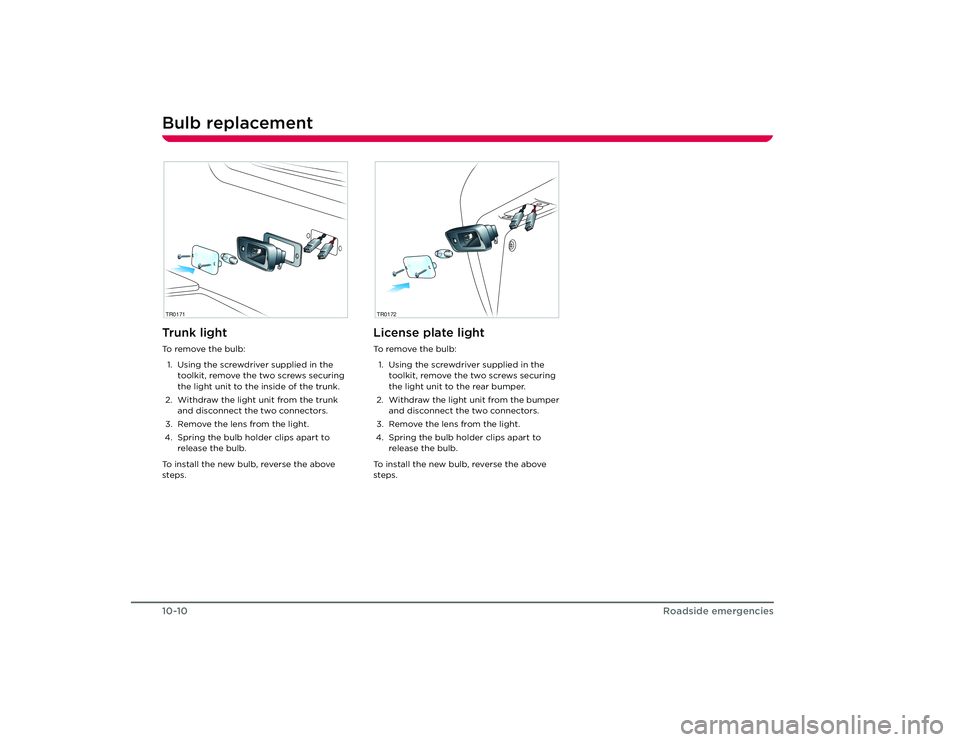
Bulb replacement10-10
Roadside emergencies
Tr u n k l i g h tTo r e m o v e t h e b u l b :1. Using the screwdriver supplied in the toolkit, remove the two screws securing
the light unit to the inside of the trunk.
2. Withdraw the light unit from the trunk and disconnect the two connectors.
3. Remove the lens from the light.
4. Spring the bulb holder clips apart to release the bulb.
To install the new bulb, reverse the above
steps.
License plate lightTo r e m o v e t h e b u l b : 1. Using the screwdriver supplied in the toolkit, remove the two screws securing
the light unit to the rear bumper.
2. Withdraw the light unit from the bumper and disconnect the two connectors.
3. Remove the lens from the light.
4. Spring the bulb holder clips apart to release the bulb.
To install the new bulb, reverse the above
steps.
TR0171
TR0172
Roadster OHB.book Page 10 Thursday, October 2, 2008 8:59 AM
Page 87 of 115
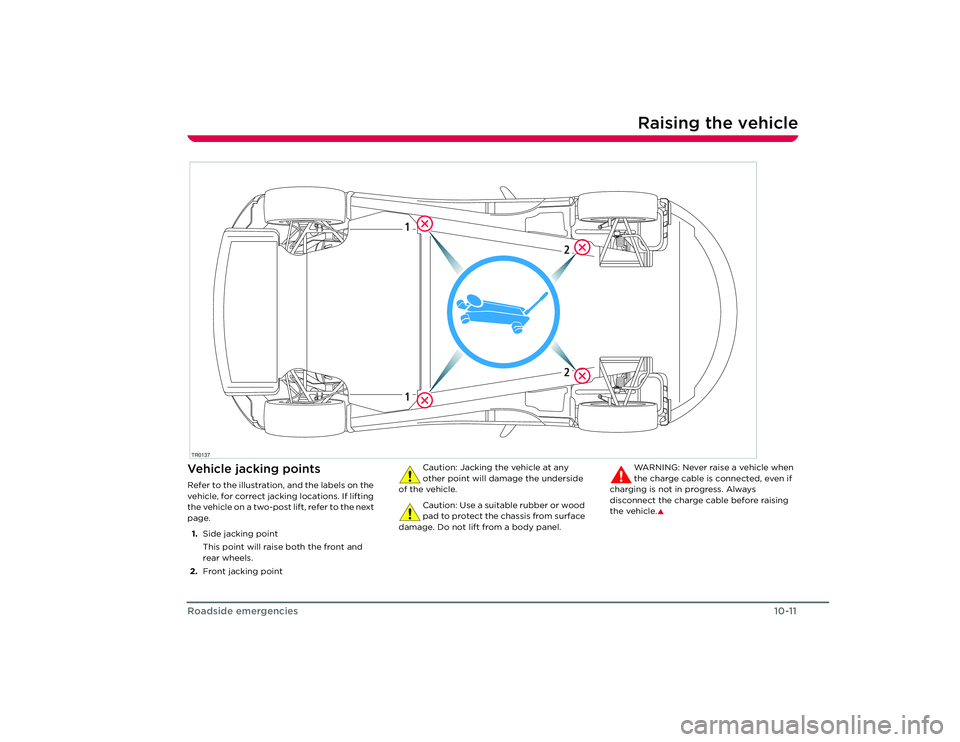
Raising the vehicle
10-11
Roadside emergencies
Raising the vehicleVehicle jacking pointsRefer to the illustration, and the labels on the
vehicle, for correct jacking locations. If lifting
the vehicle on a two-post lift, refer to the next
page.
1. Side jacking point
This point will raise both the front and
rear wheels.
2. Front jacking point Caution: Jacking the vehicle at any
other point will damage the underside
of the vehicle.
Caution: Use a suitable rubber or wood
pad to protect the chassis from surface
damage. Do not lift from a body panel. WARNING: Never raise a vehicle when
the charge cable is connected, even if
charging is not in progress. Always
disconnect the charge cable before raising
the vehicle.
�S
TR0137
11
22
Roadster OHB.book Page 11 Thursday, October 2, 2008 8:59 AM
Page 88 of 115
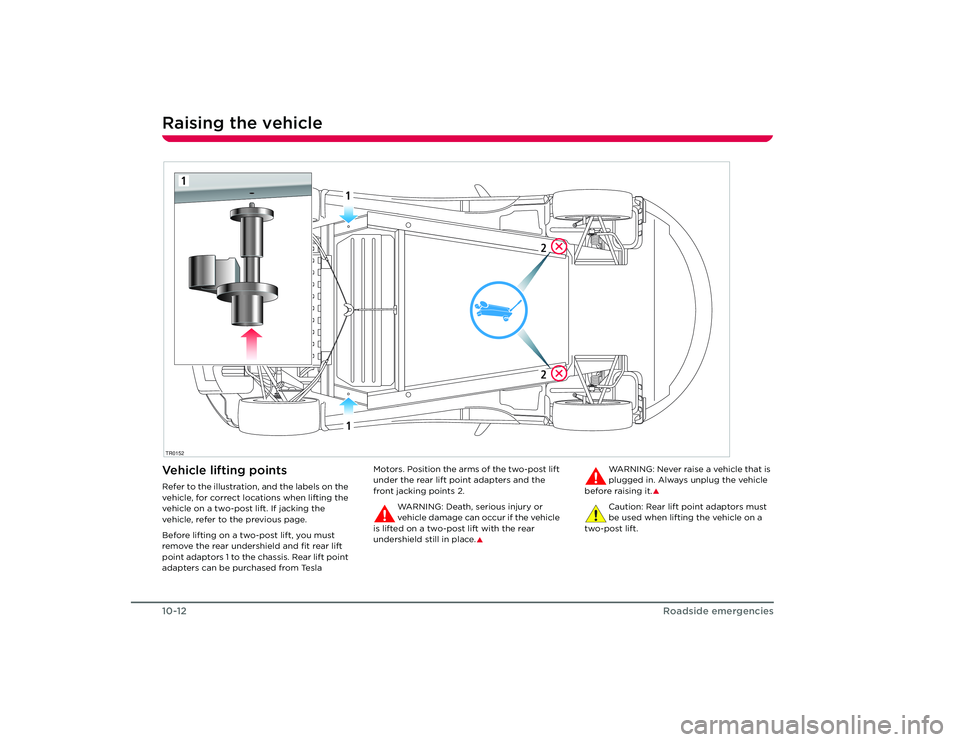
Raising the vehicle10-12
Roadside emergencies
Vehicle lifting points Refer to the illustration, and the labels on the
vehicle, for correct locations when lifting the
vehicle on a two-post lift. If jacking the
vehicle, refer to the previous page.
Before lifting on a two-post lift, you must
remove the rear undershield and fit rear lift
point adaptors 1 to the chassis. Rear lift point
adapters can be purchased from Tesla Motors. Position the arms of the two-post lift
under the rear lift point adapters and the
front jacking points 2.
WA R N I N G : D e a t h , s e r i o u s i n j u r y o r
vehicle damage can occur if the vehicle
is lifted on a two-post lift with the rear
undershield still in place.
�S
WARNING: Never raise a vehicle that is
plugged in. Always unplug the vehicle
before raising it.
�S
Caution: Rear lift point adaptors must
be used when lifting the vehicle on a
two-post lift.
TR0152
11
22
1
Roadster OHB.book Page 12 Thursday, October 2, 2008 8:59 AM
Page 89 of 115
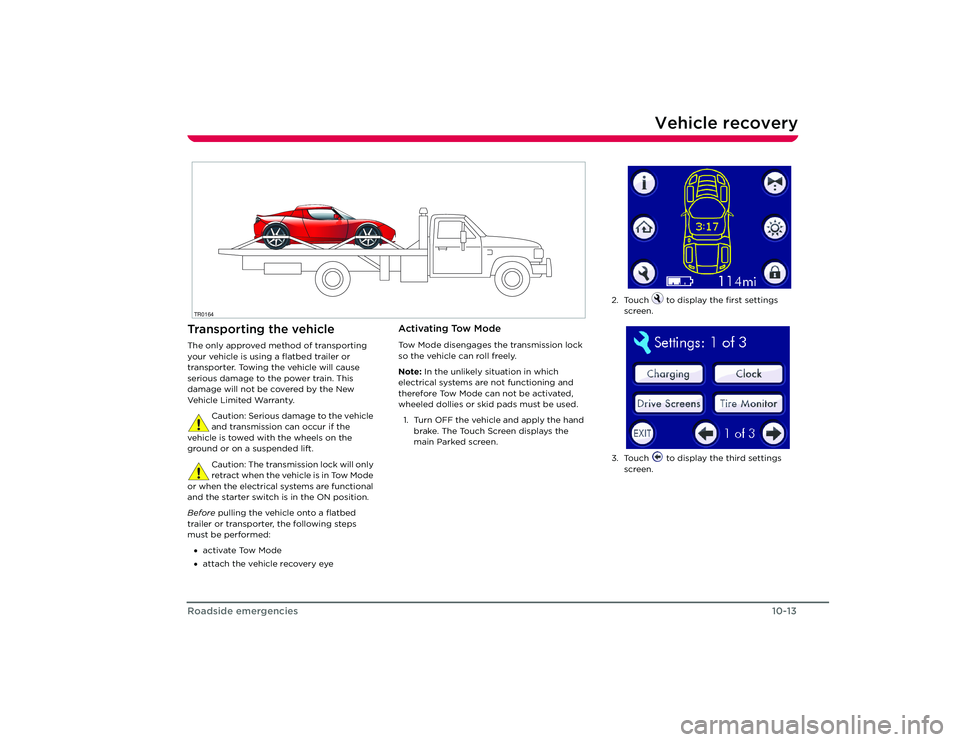
Vehicle recovery
10-13
Roadside emergencies
Vehicle recoveryTransporting the vehicleThe only approved method of transporting
your vehicle is using a flatbed trailer or
transporter. Towing the vehicle will cause
serious damage to the power train. This
damage will not be covered by the New
Ve h i c l e L i m i t e d Wa r ra n t y.
Caution: Serious damage to the vehicle
and transmission can occur if the
vehicle is towed with the wheels on the
ground or on a suspended lift.
Caution: The transmission lock will only
retract when the vehicle is in Tow Mode
or when the electrical systems are functional
and the starter switch is in the ON position.
Before pulling the vehicle onto a flatbed
trailer or transporter, the following steps
must be performed:
• activate Tow Mode
• attach the vehicle recovery eye
Activating Tow ModeTow Mode disengages the transmission lock
so the vehicle can roll freely.
Note: In the unlikely situation in which
electrical systems are not functioning and
therefore Tow Mode can not be activated,
wheeled dollies or skid pads must be used.
1. Turn OFF the vehicle and apply the hand brake. The Touch Screen displays the
main Parked screen.
TR0164
2. Touch to display the first settings screen.
3. Touch to display the third settings screen.
Roadster OHB.book Page 13 Thursday, October 2, 2008 8:59 AM
Page 90 of 115
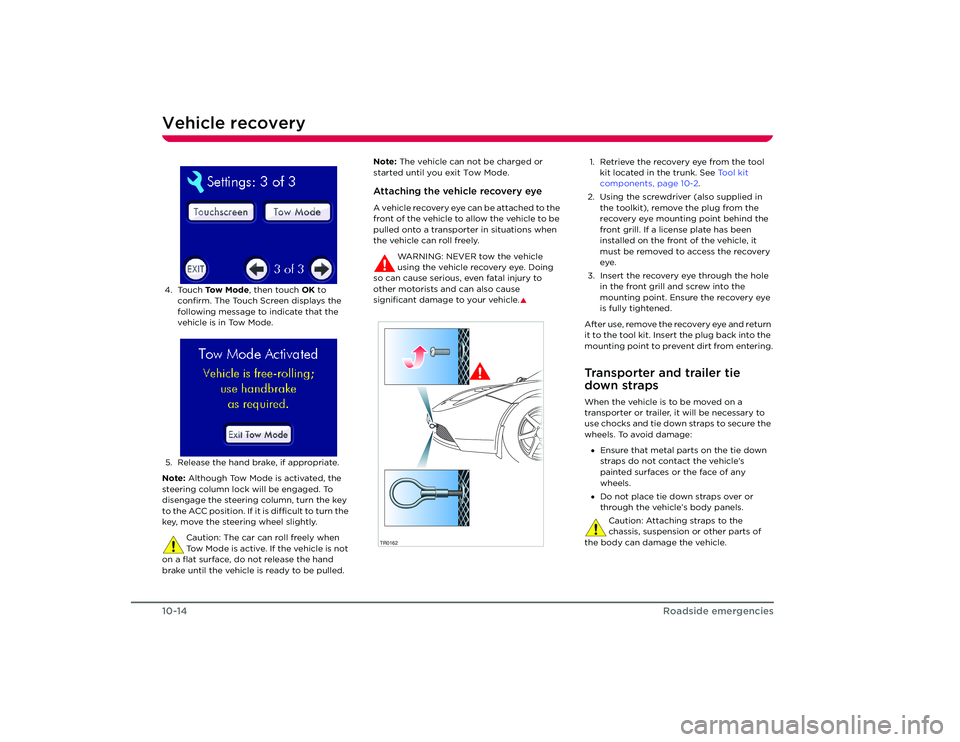
Vehicle recovery10-14
Roadside emergencies
4. Touch To w M o d e , then touch OK to
confirm. The Touch Screen displays the
following message to indicate that the
vehicle is in Tow Mode.
5. Release the hand brake, if appropriate.
Note: Although Tow Mode is activated, the
steering column lock will be engaged. To
disengage the steering column, turn the key
to the ACC position. If it is difficult to turn the
key, move the steering wheel slightly.
Caution: The car can roll freely when
Tow Mode is active. If the vehicle is not
on a flat surface, do not release the hand
brake until the vehicle is ready to be pulled. Note:
The vehicle can not be charged or
started until you exit Tow Mode.
Attaching the vehicle recovery eyeA vehicle recovery eye can be attached to the
front of the vehicle to allow the vehicle to be
pulled onto a transporter in situations when
the vehicle can roll freely.
WARNING: NEVER tow the vehicle
using the vehicle recovery eye. Doing
so can cause serious, even fatal injury to
other motorists and can also cause
significant damage to your vehicle.
�S
1. Retrieve the recovery eye from the tool kit located in the trunk. See Tool kit
components, page 10-2.
2. Using the screwdriver (also supplied in the toolkit), remove the plug from the
recovery eye mounting point behind the
front grill. If a license plate has been
installed on the front of the vehicle, it
must be removed to access the recovery
eye.
3. Insert the recovery eye through the hole in the front grill and screw into the
mounting point. Ensure the recovery eye
is fully tightened.
After use, remove the recovery eye and return
it to the tool kit. Insert the plug back into the
mounting point to prevent dirt from entering.Transporter and trailer tie
down strapsWhen the vehicle is to be moved on a
transporter or trailer, it will be necessary to
use chocks and tie down straps to secure the
wheels. To avoid damage: • Ensure that metal parts on the tie down
straps do not contact the vehicle’s
painted surfaces or the face of any
wheels.
• Do not place tie down straps over or
through the vehicle’s body panels.
Caution: Attaching straps to the
chassis, suspension or other parts of
the body can damage the vehicle.
TR0162
Roadster OHB.book Page 14 Thursday, October 2, 2008 8:59 AM